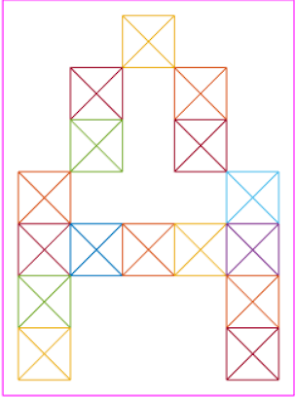Pattern Recognition and Dynamic Character Using Neural Network.
Defining the Problem
The script prprob defines a matrix X with 26 columns, one for each letter of the alphabet. Each column has 35 values which can either be 1 or 0. Each column of 35 values defines a 5x7 bitmap of a letter.
The matrix T is a 26x26 identity matrix which maps the 26 input vectors to the 26 classes.
[X,T] = prprob;
Here A, the first letter, is plotted as a bit map.
plotchar(X(:,1))Creating the First Neural Network
To solve this problem we will use a feedforward neural network set up for pattern recognition with 25 hidden neurons.Training the first Neural Network
The function train divides up the data into training, validation and test sets. The training set is used to update the network, the validation set is used to stop the network before it overfits the training data, thus preserving good generalization. The test set acts as a completely independent measure of how well the network can be expected to do on new samples.Training the Second Neural NetworkWe would like the network to not only recognize perfectly formed letters, but also noisy versions of the letters. So we will try training a second network on noisy data and compare its ability to generalize with the first network.
Testing Both Neural NetworksnoiseLevels = 0:.05:1; numLevels = length(noiseLevels); percError1 = zeros(1,numLevels); percError2 = zeros(1,numLevels); for i = 1:numLevels Xtest = min(max(repmat(X,1,numNoise)+randn(35,26*numNoise)*noiseLevels(i),0),1); Y1 = net1(Xtest); percError1(i) = sum(sum(abs(Tn-compet(Y1))))/(26*numNoise*2); Y2 = net2(Xtest); percError2(i) = sum(sum(abs(Tn-compet(Y2))))/(26*numNoise*2); end figure plot(noiseLevels,percError1*100,'--',noiseLevels,percError2*100); title('Percentage of Recognition Errors'); xlabel('Noise Level'); ylabel('Errors'); legend('Network 1','Network 2','Location','NorthWest')








Is it Fruitful?
ReplyDelete